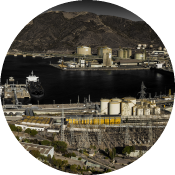 Safety
Safety

 breadcrumb_contenido
breadcrumb_contenido
 SAFETY
SAFETY
The current legal reference of the Port Authorities, is Legislative RD 2/2011, of 5 September, which approves the Revised Text of the Law for State Ports and the Merchant Navy, which establishes that the main goal of port services is to ensure the transfer of goods between land and sea means of transport in conditions of efficiency, economy, speed and safety.
It also establishes that one of the duties of the Port Authorities is to control compliance with the Regulations for Hazardous Goods, and Safety in the port area.
The Port Authority of Cartagena has vast safety experience in loading/unloading and handling of hazardous goods, due to the high volume of traffic that these type of goods represent.
Port Area
The entire port area has a closed perimeter with restricted access that is controlled by the security service and Port Police. CCTV is installed, with permanent recording on digital media, connected through fiber optics and centralized at the Control Centre.
Emergency Control center
This Control Centre is equipped with computer management systems for alarms, dangerous goods, emergencies, communications, accesses, video surveillance, recording, etc... The Control Centre is operational 24 hours a day, 365 days a year, with the service being provided by qualified staff.
The Local Coordination Rescue Centre (in Spanish C.L.C.S.) of the State Society for Marine Search and Rescue (in Spanish SASEMAR) is also in this Centre, and whose operators share a room with those of the Port Authority, in order to integrate and coordinate all maritime-port matters from the Control Centre, regardless of the legal powers that the law grants to each agency.
Internal Emergency Plan (IEP) (PEI)
RD 145/1989 of 20 January, which approves the National Regulation for the Admission, Handling and Storage of Dangerous Goods in Ports, establishes for ports that in addition to the general measures for the protection of property and people, areas in which operations for handling, storage and internal transport of dangerous goods are undertaken must have an IEP, with the corresponding self-protection organization, provided with its own resources, for risk prevention, alarm, evacuation and relief actions, as well as fire extinction, rescue, life-saving and recovery of essential services whenever possible.
APC has implemented the IEP since 1992, being permanently updated, and disseminated throughout the entire port community.
In addition to the aforesaid RD it is necessary to have a Safety Study that contains the assessment of the risks of fire, explosion, spills or leaks, as well as maritime pollution where dangerous goods are involved and in those cases in which it is expected that there may be serious consequences for the surroundings of the Port Areas.
Authorized concession companies and self-provider companies and service providers located within the site of the Port of Cartagena, must also have an own Emergency Plan, as well as the material means to control emergencies whose scope and content will depend on the nature of the activities carried out in the aforementioned companies.
Internal Maritime Plan (IMP)
RD 1695/2012, of 21 December, which approves the National Response System for maritime pollution incidents, obliges the Port Authorities to develop an IMP of the ports it manages and administers and thus reflect the different response mechanisms to cases of accidental or deliberate marine pollution, whatever their origin or nature.
To comply with such regulations, the Port Authority of Cartagena has developed an IMP applicable to the entire Port of Cartagena, which among other objectives includes the organizational structure of the emergency and the general lines of action when faced with an event of a spill at sea, and establishes the coordination and collaboration formulas between the different plans that are activated, either at communications level as well as the means to combat marine pollution.
There are various facilities within the Port of Cartagena, either under a concession system, authorized companies, suppliers of fuel and waste collection, and each of them has its own IMP and/or Report with its response system and allocation of their own resources.






